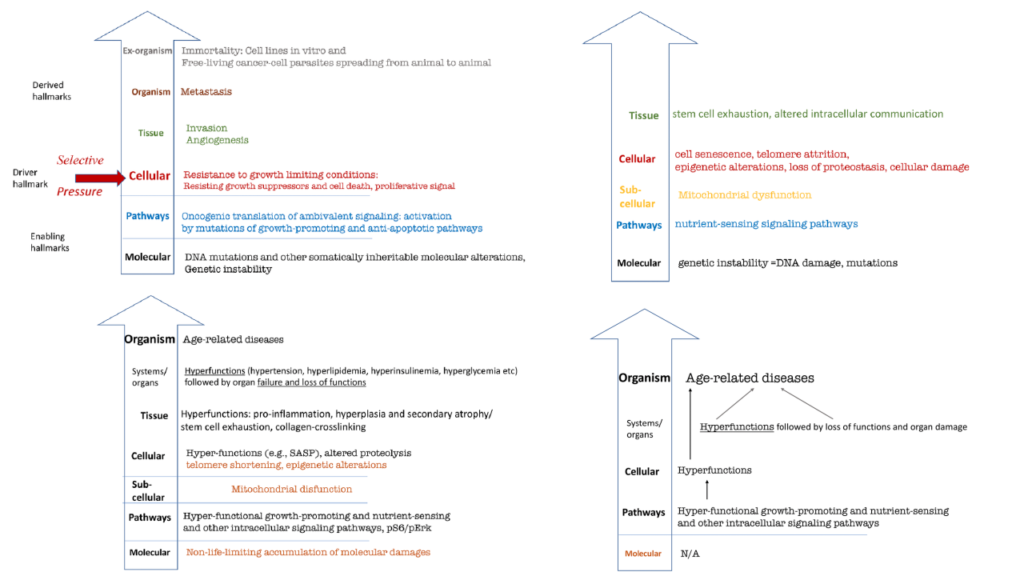Dr. Mikhail Blagosklonny published an original review paper in Aging (Aging-US) Volume 14, Issue 9, entitled, “Hallmarks of cancer and hallmarks of aging.”
In 2000 and 2011, Drs. Douglas Hanahan and Robert Weinberg authored two papers which stand as the original hallmarks of cancer. Since then, the hallmarks of cancer have been used as a critical framework to develop effective new cancer theranostics. In 2013, López-Otín et al. used the hallmarks of cancer in an effort to construct hallmarks of aging. However, in 2021, Drs. David Gems and João Pedro de Magalhães authored a paper critiquing the hallmarks of aging as a paradigm and urging researchers to move beyond the hallmarks to better understand the process of aging.
On May 9, 2022, Dr. Mikhail Blagosklonny published an original review paper in Aging (Aging-US) Volume 14, Issue 9, entitled, “Hallmarks of cancer and hallmarks of aging.” Dr. Blagosklonny expands on Gems and de Magalhães’ sentiment and writes that “canonic hallmarks of aging are superficial imitations of the hallmarks of cancer.” He takes their work to the next level by offering his own original concept that rearranges the hallmarks of cancer and the hallmarks of aging based on the hierarchical principle and the hyperfunction theory of aging.
“According to hyperfunction theory, aging is a continuation of developmental and reproductive programs that were not turned off upon their completion.”
The Hallmarks of Cancer
In Dr. Blagosklonny’s review, he explains that the hallmarks of cancer cannot be compared as equal, and some hallmarks should be combined. In Figure one, he presents the hallmarks of cancer within six hierarchically arranged levels:
- Molecular level: Somatically inheritable molecular alterations.
- Intracellular signaling pathways level: Oncogenic translation of ambivalent signaling
- Cellular level: Resistance to growth-limiting conditions
- Tissue level: Invasion and angiogenesis
- Organismal level: Metastasis
- Extra-organismal level: Cellular immortality
“Here I present the hallmarks of cancer, depicted as a circle by Hanahan and Weinberg [1], not as the circle but hierarchically, from molecular levels to the organism (Figure 1).”
The Hallmarks of Aging
Next, Dr. Blagosklonny depicts the hallmarks of aging using the hierarchical principle. He includes five levels in this representation, including molecular, pathways, subcellular, cellular, and tissue.
“This representation renders hallmarks tangible but reveals three shortcomings (Figure 2).”
After hierarchically arranging the hallmarks of aging, Dr. Blagosklonny identifies a few problems, which he refers to as “shortcomings.” He notes that the first shortcoming is a lack of hallmarks on the organismal level. The second is the unclear relationship between hallmarks on different levels. The third shortcoming is that including genetic instability as a hallmark is based on the theory that aging is caused by the accumulation of molecular damage.
“The molecular damage theory was refuted by key experiments, as discussed in detail [44–51].”
Dr. Blagosklonny then uses the hyperfunction theory to hierarchically arrange the hallmarks of aging into seven levels. (The illustration shown below in Figure three is applicable specifically to humans.)
“Let us depict hallmarks of aging, according to the hyperfunction theory of aging (Figure 3).”
Conclusion
Dr. Blagosklonny provides an in-depth explanation of the hallmarks of aging in relation to the hyperfunction theory. He also explains that the key to understanding aging is differentiating between life-limiting and non-life-limiting hallmarks. Dr. Blagosklonny includes one final figure that depicts only life-limiting hallmarks of aging. The figure can be applied to any species, from C. elegans to humans.
Toward the end of his review paper, he discusses aging as a selective force for cancer, and concludes by discussing the common hallmarks of cancer, aging and cell senescence.
“In organismal aging, cancer and cellular senescence, the same key signaling pathways, such as mTOR, are involved. This is why the same drugs, such as rapamycin, can suppress all of them.”
Click here to read the full review paper published by Aging (Aging-US).
AGING (AGING-US) VIDEOS: YouTube | LabTube | Aging-US.com
—
Aging (Aging-US) is an open-access journal that publishes research papers bi-monthly in all fields of aging research. These papers are available at no cost to readers on Aging-us.com. Open-access journals have the power to benefit humanity from the inside out by rapidly disseminating information that may be freely shared with researchers, colleagues, family, and friends around the world.
For media inquiries, please contact [email protected].

